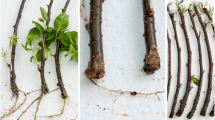Abstract
The ability of poplars (Populus sp.) and poplar hybrids to form adventitious roots is critical to the commercial deployment of intensively cultured poplar plantings, because the propagule of choice for such plantings is an unrooted dormant hardwood cutting. Given the importance of rooting ability, it is difficult to explain the shortage of quantitative genetic understanding of rooting compared to other commercially important traits. One reason for the aforementioned lack of knowledge is that genetic selection for rooting ability is mostly applied incidentally during serial propagation between stages of field testing for growth potential and disease resistance. Clones that root poorly are automatically eliminated from the testing process. However, such incidental selection provides little knowledge about selection efficiency, or possible correlated effects of selection for rooting ability, on other important traits. Likewise, incidental selection does not lead to the identification of more easily evaluated above-ground traits that could be used as indirect selection criteria for rooting ability.
Access this chapter
Tax calculation will be finalised at checkout
Purchases are for personal use only
Preview
Unable to display preview. Download preview PDF.
Similar content being viewed by others
References
Farmer, R.E., Jr., Freitag, M. and Garlick, K., 1989, Genetic variance and “C” effects in balsam poplar rooting, Silv. Genet. 38:62.
Riemenschneider, D.E., McMahon, B.E., and Ostry, M.E., 1993, Population-dependent selection strategies needed for 2-year-old black cottonwood clones, Can J. For Res. 24: 1704.
Wilcox, J.R., and Farmer, R.E., Jr., 1967, Variation and inheritance of juvenile characters of eastern cottonwood, Silv. Genet. 16: 162.
Wilcox, J.R., and Farmer, R.E., Jr., 1968, Heritability and C effects in early root growth of eastern cottonwood cuttings, Heredity 23: 239.
Ying, C.C., and Bagley, W.T., 1977, Variation in rooting capability of Populas deltoides, Silv. Genet. 26:204.
Author information
Authors and Affiliations
Editor information
Editors and Affiliations
Rights and permissions
Copyright information
© 1997 Springer Science+Business Media New York
About this chapter
Cite this chapter
Riemenschneider, D.E., Bauer, E.O. (1997). Quantitative Genetic Analysis of Adventitious Root Forming Ability in Populus trichocarpa (Torr Et. Gray). In: Altman, A., Waisel, Y. (eds) Biology of Root Formation and Development. Basic Life Sciences, vol 65. Springer, Boston, MA. https://doi.org/10.1007/978-1-4615-5403-5_36
Download citation
DOI: https://doi.org/10.1007/978-1-4615-5403-5_36
Publisher Name: Springer, Boston, MA
Print ISBN: 978-1-4613-7467-1
Online ISBN: 978-1-4615-5403-5
eBook Packages: Springer Book Archive




